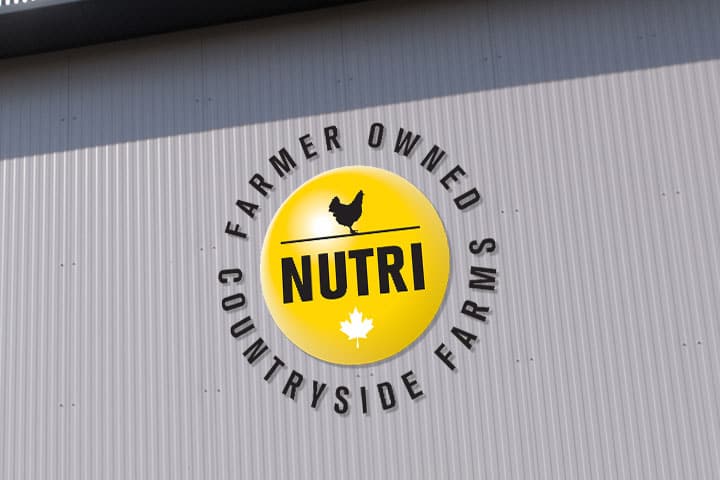


Are you looking for an answer to your questions?
If we haven’t answered your question, contact us!
Contact usQuick search
Enter a search keyword to find matching topics.
All eggs are first sent to the grading station before being shipped to the grocery store. There, they are washed in a sanitizing solution and scrubbed with rotating brushes to remove any dirt or bacteria on the shell. There’s no need to wash your eggs at home.
In Canada, egg producers use a variety of housing systems for their hens. Each housing system offers a clean environment, fresh food and water, and protection from predators. Moreover, given Canada’s variable climate, most hens are housed in temperature-controlled poultry houses, which allows producers to keep the barn at a consistent temperature and protect the hens from inclement weather.
In conventional systems, hens are housed in small groups and have easy access to feed and water. Enhanced systems are equipped with perches and a curtained-off area where the hens lay their eggs. In free-range systems, the hens move freely across the floor. Some poultry houses are also equipped with multi-storey aviaries. Lastly, free-range housing systems also allow hens to go outdoors.
Canadian eggs are produced by more than 1,000 egg-farming families in every province and in the Northwest Territories. No matter where you buy your eggs, you can rest assured that they were produced in your region.
Canadian eggs do not contain steroids or hormones. Canadian egg farmers follow the Canadian Food Inspection Agency’s Feed Regulations, which state that the use of added steroids and hormones is prohibited in Canada.
Eggshell colour depends on the breed of hen. As a general rule, white shell eggs are produced by white-feathered hens, while brown-shelled eggs come from hens with brown-feathered hens. There is no nutritional difference between brown and white eggs, unless the hen’s diet has been enriched to produce specialty eggs.
Raw eggs can be frozen unshelled. Simply crack the shell, remove it and place the egg in an airtight container. If you only want to freeze the yolk, add a pinch of sugar or salt to keep it from gelling.
Canadian egg farmers participate in a national Animal Care Program and a comprehensive on-farm food safety program called Start-Clean, Stay-Clean™. Developed by Canada’s leading experts, these national programs set important guidelines based on the latest research and information. Inspections are conducted by trained field inspectors and audited against Egg Farmers of Canada’s national programs.
The latest technology available on the poultry market allows for constant monitoring of hen feed consumption, house temperature and many other factors. Monitoring systems are also in place, but producers still heavily rely on daily house checks.
After leaving the farm, the eggs go to the grading station, where they are washed, graded and packed. They are then shipped to different grocery stores in refrigerated trucks. As soon as they arrive in store, the eggs are placed in cold storage or in a refrigerated display case to keep them fresh. Across Canada, eggs go from farm to store in less than a week.
Responsible animal husbandry is a priority for Canadian egg producers, all of whom ethically care for their animals. Breeding methods adhere to the national Animal Care Program, which is rooted in the National Code of Practice. This Code of Practice was created in partnership with leading veterinarians and scientists, as well as representatives from the Canadian Federation of Humane Societies, industry and government. Producers fund a number of independent research projects on welfare and farming practices, and are committed to applying this knowledge throughout the industry.
Eggs that are sold as “organic” are produced according to specific standards set by the Canadian General Standards Board and certified by a recognized organization. All eggs labelled “organic” in Canada are produced in free-roaming systems where hens are fed certified organic feed.
A fresh egg placed in a bowl of water will sink to the bottom, but an egg that is no longer fresh will float to the surface. This phenomenon occurs as moisture evaporates and air expands in the egg’s inner chamber over time. However, you can still eat an egg that floats, just like you can eat an egg that has passed the best-before date on the carton.
This date is an indication of how long eggs will retain their Grade A quality. An egg consumed after this date is simply less fresh but has not lost its nutritional value. Use these eggs in recipes instead.
Each year, Canadian egg farmers produce an average of 650 million dozen eggs. Nutri Group’s farmers alone produce 2 billion regular, free range, organic, specialty, and processed eggs.
The average hen lays an egg almost every day.
No, quite the opposite. The egg white is 90% water and contains part of the egg’s protein. By eating only the white, you’re depriving yourself of all the nutrients the yolk contains: the other portion of protein, unsaturated fats (including omega 3), vitamins, minerals, antioxidants and other nutrients.
The eggs you buy at the grocery store have never been fertilized, and the laying hens have never seen a rooster in their lives. So, you can be sure that you’ll never find a chick in any egg.
An egg with a blood spot is safe to eat. Blood spots are merely caused by a ruptured blood vessel during egg formation. They account for less than 1% of eggs and are usually sorted out from the rest. However, since it’s harder to see the blood spots in brown eggs, some can slip through among the others. If you like, you can remove the blood with the tip of a clean knife before cooking the egg.
Decades of research have confirmed that dietary cholesterol (the cholesterol found in food) has no effect on blood cholesterol levels and does not increase the risk of heart disease. You can eat eggs daily as part of a varied and balanced diet.
Health Canada, the Canadian Paediatric Society, Dietitians of Canada and the Breastfeeding Committee of Canada recommend introducing whole eggs as early as six months or as soon as your child starts eating solid food. Research shows that introducing whole eggs early in a baby’s diet can help reduce the risk of developing an egg allergy.
The best-before date on egg packaging refers to the length of time eggs will retain their Grade A quality, provided they are stored correctly. This date is usually 28 to 35 days after the date they are packaged. If you use eggs after this date, it’s best to use them in recipes or to serve them hard-boiled or scrambled, rather than poached or fried.
As hens age, the eggs they lay become larger but contain the same amount of calcium and therefore eggshell. The eggshell becomes thinner as hens age because the egg underneath the shell gets bigger.
A Grade A egg is the kind we find at the grocery store. For an egg to be considered Grade A, it must meet three criteria: shell condition, yolk position within the egg and air chamber size inside the shell. If the shell is uncracked, the yolk is centered and the air chamber is very small, the egg meets Canadian Grade A egg standards.
After eggs leave the farm, they are transported to a grading station for washing, candling, weighing, and packaging. Grading stations are registered with and inspected by the Canadian Food Inspection Agency.
The way you cook your eggs affects its nutritional value. To best maintain your eggs’ nutritional integrity, choose a cooking method that uses no fat such as hard-boiling or poaching.
A chicken is a young bird that hasn’t reached full maturity yet. A male chicken grows into a rooster, while a female chicken grows into a laying hen.
Firstly, there is no nutritional difference between these two types of eggs. Free-range eggs come from hens raised in poultry houses where they can move around freely on slatted or littered floors. Their living space also includes perches and nests. Free-range eggs are produced in a similar environment, but the hens also have access to an outdoor run. Given Canada’s harsh climate, the outdoor run is accessible on a seasonal basis.
Canadian egg farmers offer many egg options, all following the same high standards. No matter which type of egg you go for, they’re all delicious and nutritious choices.
One large egg contains 6 grams of protein and 14 important nutrients such as vitamins A, D and E, folate, iron, and zinc. Because they contain all 9 essential amino acids, eggs are among the few foods considered to be a complete source of protein.
Poultry producers across Canada must adhere to strict standards to ensure egg freshness and quality. They must also demonstrate that all production is local. There are two programs that egg farmers must comply with: the national Animal Care Program and an on-farm food safety program called Start-Clean, Stay-Clean™. These programs set comprehensive and rigorous standards based on the latest research provided by the nation’s leading experts.
Farms are inspected by qualified inspectors, and farmers are committed to caring for their flock in an exemplary manner in order to maintain egg safety and freshness at all times.
Our products are distributed in all parts of the country. Specifics vary by region, but most big chains offer our products. Having trouble finding what you need? Feel free to contact us by email (info@nutrigroupe.ca). We are always happy to help.
Egg size depends on the hen’s age. Over time, hens lay larger eggs. Eggs are graded by weight, not circumference, at the grading station, and are then packed and labelled according to the following sizes: peewee, small, medium, large, extra large or jumbo.
In some parts of Canada, eggs are marked with a code on the shell. This code is part of a traceability system that provides information about the egg: the name of the farm it came from, where it was graded and its best-before date. Thanks to the traceability program, producers are able to ensure access to fresh, safe, high-quality eggs at all times.
The Canadian market offers eggs that have been washed, inspected, sorted and distributed according to size, weight, etc. When we wash eggs, we strip off the protective film on the shell, and the eggs must then be stored in the refrigerator to stay fresh. A low, even temperature limits moisture loss through the pores of the eggshell. Refrigeration keeps eggs fresh until the best-before date shown on the packaging.
Egg yolk colour is affected by the hen’s diet. Generally speaking, if a hen is fed a wheat-based diet, she will lay eggs with paler yolks. On the other hand, if she eats corn or alfalfa, she will tend to lay eggs with darker yolks.
Désolé, il semble que votre recherche n'ait abouti à aucun résultat. Veuillez contacter notre équipe technique à l'adresse suivante info@nutrigroupe.ca.
 Star Egg
Star Egg
 Counstryside Farms
Counstryside Farms
 Nutri-œuf
Nutri-œuf
 Maritime Pride Eggs
Maritime Pride Eggs
 Supreme Egg Products
Supreme Egg Products